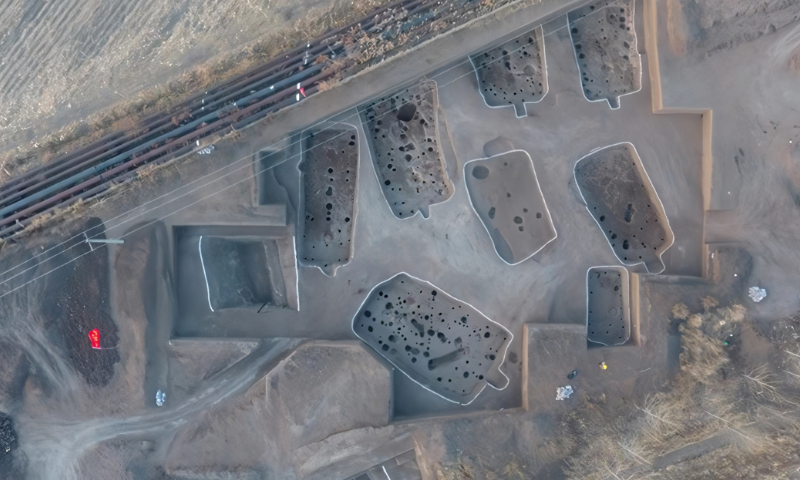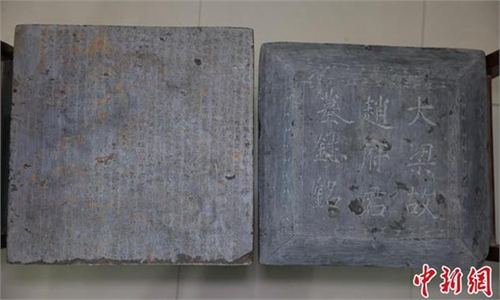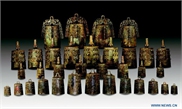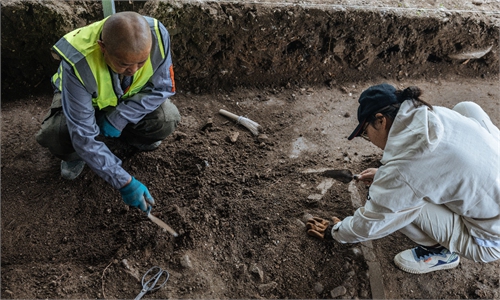ARTS / ART
Ancient DNA uncovers some domestic dogs introduced into China via Eurasian steppe route 6,000 years ago

The Honghe site in North China's Heilongjiang Province. Photo: Courtesy of Wang Xincheng's archaeological team form the Archaeological Institute of Jilin University.
Based on an analysis of ancient DNA from domestic dogs in China, researchers have recently discovered that European dogs' influence reached Northeast China as early as 6,000 to 5,500 years ago. This indicates that cultural exchanges between the eastern and western Eurasian continents were already present in Northeast China during that period, according to a document that Wang Xincheng's archaeological team of the Archaeological Institute of Jilin University sent to the Global Times on Wednesday.
At the Honghe site in Northeast China's Heilongjiang Province, a large number of animal bones were excavated. Domestic dogs were the only domesticated animals during the Neolithic period (7000-1700 BCE). As companions of humans, domestic dogs have a domestication and diffusion process closely linked to human activity.
Wang told the Global Times that from the perspective of ancient DNA research, current studies on ancient domestic dog's DNA primarily focus on constructing the spatiotemporal framework of their origins and domestication, while relatively little attention has been given to how domestic dogs reflect the evolutionary processes of human societies.
"Determining the sex of domestic dogs based on morphology is quite challenging, as the baculum [penis bone] is rarely preserved. However, ancient DNA technology has effectively addressed this issue, making it possible for us to accurately identify the sex of ancient domestic dogs," Wang said.
He noted that he and his team aim to analyze the ancient DNA of canine remains from the Honghe site, in conjunction with their excavation context, to reconstruct the shifts in subsistence patterns of ancient humans from the Neolithic to the Bronze Age (2,000BC to 700BC) and the potential cultural exchanges that may have occurred.
"We extracted ancient DNA data from 28 canid specimens through ancient DNA analysis, which allowed us to determine the maternal haplotypes of the samples, and identify their sex," he said.
The results indicate that haplotype A is the primary maternal haplotype of domestic dogs at the Honghe site, with most A-type dogs showing genetic similarities to domestic dogs in Northeast Asia and the Pacific Islands while being distantly related to ancient samples from other regions of China. Additionally, two major haplotypes, B and C, associated with European domestic dogs were also found at the Honghe site.
Previous studies had shown that haplotypes B and C are closely related to ancient European domestic dogs. The presence of haplotypes C and B indicates that the domestic dogs at the Honghe site had already been influenced by European breeds during this period.
"The discovery of B and C type domestic dogs in Northeast China suggests that cultural exchanges between the eastern and western Eurasian continents had been established in this region at least 6,000 to 5,500 years ago," Wang said.
He noted that the presence of B-type dogs, closely related to European breeds, implies that this influence was not a transient occurrence but a sustained one.
This research further confirms that during the late Neolithic to Bronze Age, ancient domestic dogs at the Honghe site were influenced by European breeds, primarily through the eastward and southward transmission along the Eurasian steppes into the Nenjiang River basin.
"This discovery not only provides a new perspective for understanding the history of the region, but also opens new avenues for studying the lifestyles and cultural exchanges of ancient populations in other areas. Other archaeological projects can adopt our approach of analyzing ancient DNA from animal remains within the excavation context to gain a more comprehensive understanding of ancient human life," Wang said.



